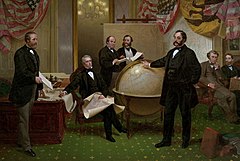Holidays, observances, and celebrations in the United States
January January–February FebruaryAmerican Heart Month Black History Month Birthday of Luis Muñoz Marín (PR) Candlemas (religious) Charles Darwin Day / Darwin Day (CA, DE) Day of Remembrance (CA, OR, WA, cultural) Georgia Day (GA) Groundhog Day Imbolc (religious) Lincoln's Birthday (CA, CT, IL, IN, MO, NY, WV) National Girls and Women in Sports Day National Freedom Day (36) Nirvana Day (religious) Presentation of Our Lord to the Temple (religious) Promised Reformer Day (religious) Ronald Reagan Day (CA) Rosa Parks Day (CA, MO) Saviours' Day (religious) Susan B. Anthony Day (CA, FL, NY, WI, WV, proposed federal) Tu B’shvat (religious) February–March MarchIrish-American Heritage Month Colon Cancer Awareness Month Women's History Month Annunciation of the Virgin Mary / Annunciation of the Theotokos (religious) Casimir Pulaski Day (IL) Cesar Chavez Day (CA, CO, TX, proposed federal) Emancipation Day in Puerto Rico (PR, cultural) Evacuation Day (Suffolk County, MA) Harriet Tubman Day (NY) Hola Mohalla (religious) Holi (NY, religious) L. Ron Hubbard's Birthday (religious) Lailat al-Mi'raj (religious) Liberation and Freedom Day (Charlottesville, VA, cultural) Mardi Gras (AL (in two counties), LA) Maryland Day (MD) Medal of Honor Day National Poison Prevention Week (week) Nowruz (cultural, religious) Ostara (religious) Pi Day Prince Jonah Kūhiō Kalanianaʻole Day (HI) Promised Messiah Day (religious) Saint Joseph's Day (religious) Seward's Day (AK) Texas Independence Day (TX) Town Meeting Day (VT) Transfer Day (VI) U.S. Hostage and Wrongful Detainee Day (36) Trans Day of Visibility (cultural) March–April Good Friday (CT, NC, PR, NJ, VI, religious) Hanuman Jayanti (religious) Holy Thursday (PR, VI, religious) Holy Week (PR, religious, week) Lazarus Saturday (religious) Mahavir Janma Kalyanak (religious) Mesha Sankranti / Hindu New Year (religious) Palm Sunday (PR, religious) Passover (religious, week) Easter Monday / Bright Monday (VI, religious) Ramnavami (religious) Chandramana Uugadi / Souramana Uugadi (religious) AprilArab American Heritage Month Confederate History Month MayAsian American and Jewish American Heritage Month Military Appreciation Month JunePride Month July July–August August SeptemberProstate Cancer Awareness Month Childhood Cancer Awareness Month Gospel Music Heritage Month September–OctoberHispanic Heritage Month OctoberBreast Cancer Awareness Month Disability Employment Awareness Month Italian-American Heritage and Culture Month Filipino American History Month LGBT History Month October–November NovemberNative American Indian Heritage Month Ascension of ‘Abdu’l Baha (religious) All Saints' Day (religious) Beginning of the Nativity Fast (religious) Beltane / Samhain (religious) Barack Obama Day in Alabama (Perry County, AL) D. Hamilton Jackson Day (VI) Day after Thanksgiving (24) Day of the Covenant (religious) Discovery of Puerto Rico Day (PR) Election Day (CA, DE, HI, KY, MT, NJ, NY, OH, PR, VA, WV, proposed federal) Family Day (NV) Friendsgiving Guru Nanak Gurpurab (religious) Hanukkah (religious) Lā Kūʻokoʻa (HI, unofficial, cultural) Martyrdom of Guru Tegh Bahadur (religious) Native American Heritage Day (MD, WA, cultural) Presentation of the Theotokos to the Temple (religious) Trans Day of Remembrance (cultural) Unthanksgiving Day (cultural) December Advent Sunday (religious) Alabama Day (AL) Birthday of Guru Gobind Singh Sahib (religious) Bodhi Day (religious) Chalica (religious) Christmas Eve (KY, NC, SC, PR, VI) Day after Christmas (KY, NC, SC, TX, VI) Festivus HumanLight Hanukkah (religious, week) Immaculate Conception (religious) Indiana Day (IN) Kwanzaa (cultural, week) Milad Syedna Mohammed Burhanuddin (religious) National Pearl Harbor Remembrance Day (36) Nativity of Jesus (religious) Old Year's Night (VI) Pan American Aviation Day (36) Pancha Ganapati (religious, week) Rosa Parks Day (OH, OR) Solemnity of Mary, Mother of God (religious) Wright Brothers Day (36) Yule (religious) Zartosht No-Diso (religious) Varies (year round) 